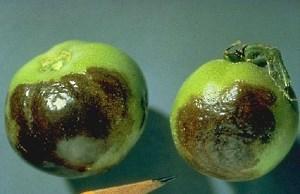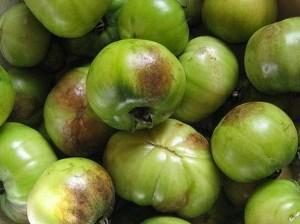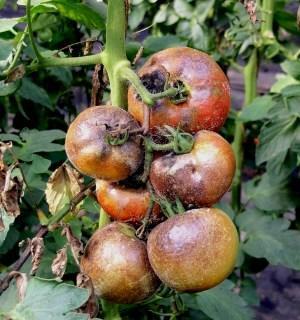Tomato varieties resistant to late blight - this is important
 Late blight is one of the most dangerous diseases to which nightshade crops are susceptible. Phytophthora on tomatoes is one of the main reasons for the death of the tomato crop in places with a humid and / or cool climate. The connection between atmospheric humidity and the appearance of brown spots on plants and fruits is so obvious that not too educated growers talk about "harmful" fogs and "poisonous" rains, although these climatic phenomena only increase the humidity and thus contribute to the growth of the fungus. There is also a significant increase in the number of diseased plants after a sharp temperature drop.
Late blight is one of the most dangerous diseases to which nightshade crops are susceptible. Phytophthora on tomatoes is one of the main reasons for the death of the tomato crop in places with a humid and / or cool climate. The connection between atmospheric humidity and the appearance of brown spots on plants and fruits is so obvious that not too educated growers talk about "harmful" fogs and "poisonous" rains, although these climatic phenomena only increase the humidity and thus contribute to the growth of the fungus. There is also a significant increase in the number of diseased plants after a sharp temperature drop.
 For a long time it was believed that the mycelium (mycelium) of the fungus Phytophthora infestans hibernate mainly on potato tubers, and tomatoes are infected from infected potato plants, but this turned out to be incorrect. Fungal spores are very resistant to frost, and therefore they can even contaminate the soil, not to mention plant debris and seeds stored in a warm place. And if it is quite possible to process the seeds before planting, then exterminate all foci of infection in the soil and greenhouse structures
For a long time it was believed that the mycelium (mycelium) of the fungus Phytophthora infestans hibernate mainly on potato tubers, and tomatoes are infected from infected potato plants, but this turned out to be incorrect. Fungal spores are very resistant to frost, and therefore they can even contaminate the soil, not to mention plant debris and seeds stored in a warm place. And if it is quite possible to process the seeds before planting, then exterminate all foci of infection in the soil and greenhouse structures
Therefore, tomato varieties resistant to late blight arouse the strongest interest among all those involved in the cultivation of this crop, both for domestic needs and on an industrial scale.
 Of course, different varieties can be recommended for certain areas and growing conditions.
Of course, different varieties can be recommended for certain areas and growing conditions.
So, for example, varieties of tomatoes resistant to late blight in Ukraine are recommended other than somewhere near Kaluga or in the Urals. This is due to the different composition of soils, and significant differences in climatic conditions.
If a summer that is too short and cool requires growing tomatoes in greenhouses, then it may be worth giving preference to hybrid varieties created specifically for growing in such conditions.
What are they?
It should be noted that early ripening tomato varieties are often offered as late blight-resistant varieties.
This is due to the fact that the longer the bush lives, the more it has, firstly, the danger of being infected, and secondly, it will endure more temperature and humidity changes that provoke the development of the disease.
 So, for example, in many regions with medium and high humidity, starting from the end of July, it becomes extremely difficult to protect tomatoes from late blight disease. Moreover, varieties that are positioned as persistent just get sick a week later or get sick less pronounced. But, unfortunately, the presence of infection still negatively affects the safety of the crop. Some of the fruits do not have time to ripen, and the ripe ones spoil too quickly.
So, for example, in many regions with medium and high humidity, starting from the end of July, it becomes extremely difficult to protect tomatoes from late blight disease. Moreover, varieties that are positioned as persistent just get sick a week later or get sick less pronounced. But, unfortunately, the presence of infection still negatively affects the safety of the crop. Some of the fruits do not have time to ripen, and the ripe ones spoil too quickly.
Nevertheless, growing resistant varieties still gives a tangible effect, but it is sometimes necessary to establish which ones are really good for specific conditions.
Someone year after year gives preference to the variety Bobkat, Cameo, Sun Fighter, De Barao, White filling 241, Moskvich, Morkovny, Moscow Lights, Otradny, Little Prince, someone is forced to plant mainly early ripening hybrids, focusing on that the plants will have time to harvest before the disease.

Tomato varieties resistant to late blight in the Moscow region include:
- Dwarf. It belongs to early maturing varieties, intended for open ground.
- Alpatieva 905 A.Designed for outdoor cultivation.
- Budenovka. Refers to medium early varieties, intended for cultivation both under a film shelter, and in the open field.
- De Barao. Late-ripening fruitful variety with good taste and technical qualities.
- De Barao is black. A late-ripening, productive shade-tolerant variety intended for growing under film and in the open field.
- Lark F1. An early ripening hybrid variety with good fruit setting, taste and technical qualities.
- Dubok (Dubrava). An early ripening high-yielding variety intended for cultivation in open ground.
- La la fa F1. Hybrid mid-season, good for any kind of use.
- Union 8 F1. Hybrid early maturing variety. Suitable for growing in open ground and greenhouses.
- Blizzard. A mid-season variety with good productivity and increased cold resistance, intended for open field cultivation.
- Tsar Peter. A mid-season cold-resistant variety, quite resistant to many diseases. Popular with summer residents, grown both in the open field and in greenhouses.
Hybrids or non-hybrids, imported or domestic?
Many amateur plant breeders appreciate the hybrid Dutch varieties in terms of resistance to late blight, however, growing vegetables for themselves, the same summer residents also recognize the rather low taste of the "Dutch". Nevertheless, domestic varieties adapted to local conditions and selected for resistance to diseases are more attractive - there is more opportunity to find your own version, both tasty and productive.
In general, the most successful varieties of tomatoes resistant to late blight in the Moscow region are either cold-resistant or early-maturing varieties, which is not surprising, given the particular climate.
In even more "not hot" regions, undersized varieties of tomatoes resistant to late blight are appreciated. This is due to the fact that initially low plants are much easier to cover from sudden frosts, because a greenhouse is not always the best option, tomatoes "love" ventilated beds and bear fruit more productively on them regardless of the variety.
You can list several domestic low-growing varieties of tomatoes resistant to late blight:
- Dwarf.
- Far North.
- Alaska.
- Polar early maturing.
- Snowdrop.
- Bullfinch.
- Rose of Wind.
- Sub-Arctic.
- Snowy tale.
- Yamal.
- Taimyr.
As it is easy to understand from the names, most of them were created with the expectation of a cool and short summer and at least partial cultivation under a film or in a greenhouse. Therefore, these varieties may not have particularly high yields, and not all of them are good for long-term transportation. But this is perfectly compensated by decent taste and the ability to grow tomatoes in places where it was considered impossible a few decades ago.
Phytophthora is a formidable enemy in the greenhouse. Having familiarized myself with the varieties resistant to the disease, I confirm that De-barao is a successful variety and is resistant to late blight in Siberia. Of the medium-sized, Partner and Budenovka stand green until the very end of the growing season. Katya, lower, but a variety suitable for the greenhouse. The early bushes listed in the article, even before the end of the season, already had time to give the crop and free the soil. Among the varieties with pink fruits, salad, I often noticed the appearance of the first signs of phytophthora. True, in the fall, I don't have leaves in the greenhouse, only at the very top of the head I leave three leaves for the last brush. Therefore, perhaps, there are no damaged fruits.